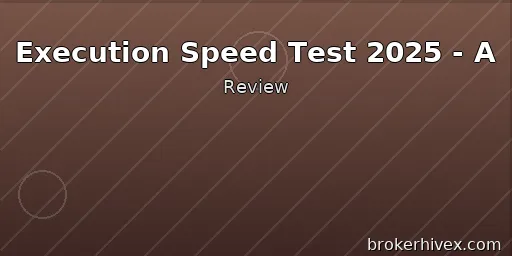 BrokerHiveX
BrokerHiveX BrokerHiveX
BrokerHiveX BrokerHiveX
BrokerHiveXSummary:Forex Platform Order Execution Speed Review 2025 | Execution speed directly impacts profitability and risk. This article compares the order execution performance of IC Markets, Pepperstone, Exness, XM, and IG Group, using scalping and non-farm payroll data examples, and citing the "backend manipulation delay" incident exposed by BrokerHiveX to help investors identify truly fast and transparent platforms.

Scalping relies on millisecond execution : high latency can lead to order failures or reduced profits;
High volatility market (such as non-farm payrolls and CPI releases) : The speed of execution determines whether stop-loss/take-profit is triggered;
Fairness and transparency : Excessive delays may not be a technical issue, but rather a result of human manipulation;
Investor confidence : Fast execution improves user experience, while delays lead to a decrease in trust.
| platform | Average execution speed | Performance during periods of high volatility | Technical Support | Regulatory situation |
|---|---|---|---|---|
| IC Markets | 30–40 milliseconds | Slight delay | New York/London servers, VPS support | ASIC, CySEC |
| Pepperstone | 35–50 milliseconds | Stable, controllable slippage | Equinix Server + VPS | FCA, ASIC |
| Exness | 40–80 milliseconds | The fluctuation period is significantly delayed | Internal risk control mechanism | FCA, CySEC |
| XM | 80–120 milliseconds | Large execution delays during periods of high volatility | MT4/MT5 Traditional Architecture | ASIC, CySEC |
| IG Group | 60–100 milliseconds | The market maker model has a large downside | Proprietary trading system | FCA, ASIC |
👉 Evidence :
ASIC official website → Check IC Markets and Pepperstone;
FCA official website → Check IG and Pepperstone UK;
CySEC official website → Check Exness and XM.
Case 1: IC Markets Scalping
A trader conducted high-frequency trading on EUR/USD during the London trading session, with an execution speed stable within 35 milliseconds.
Case 2: Pepperstone non-farm payroll trading
The user placed an order when the non-farm payroll data was released. Although slippage occurred, the transaction was within a reasonable range.
Case 3: XM Delayed Execution
Investors reported that when gold prices fluctuated significantly, order execution was delayed by more than 2 seconds, resulting in wider stop-loss orders.
Case 4: Black Platform Backstage Manipulation
An offshore platform deliberately delayed orders, preventing users from completing transactions at critical points👉 Exposed in the BrokerHiveX exposure area .
FCA (UK) : Platforms must disclose their enforcement policies and slippage handling mechanisms;
ASIC (Australia) : prohibits artificial delays and requires fair execution;
CySEC (Cyprus) : requires platforms to disclose order execution statistics;
NFA/CFTC (US) : strictly monitor backend manipulation;
MAS (Singapore) : emphasizes transparency in transaction execution.
👉Evidence : In the FCA Warnings , many cases involved "back-end delayed manipulation".
Use a VPS to test latency → Observe the time from order placement to execution;
Non-farm payroll data analysis → Compare the slippage differences between different platforms;
Cross-validation → Place orders on both platforms simultaneously and check transaction times;
Check the BrokerHiveX exposure area → Check if there are any complaints of delay manipulation.
❌ The average platform execution latency exceeds 200 milliseconds;
❌ High-frequency trading is often rejected;
❌ The platform does not disclose its enforcement policy;
❌ The offshore platform backend can be delayed or manipulated at will.
What execution speed is considered acceptable?
👉 Less than 100 milliseconds is good, and <50 milliseconds is required for scalping.
Is the delay definitely caused by manipulation by a black platform?
👉 Not necessarily. It could be a network or server location issue, but be wary of long delays.
Are market maker platforms necessarily slower?
👉 The market maker model may be slower, but a strongly regulated platform can still maintain stability.
Fastest execution : IC Markets, Pepperstone, suitable for scalping and high-frequency trading;
Medium : Exness, IG Group, latency is acceptable, but there are risks during high volatility;
Be cautious : XM may experience high latency in highly volatile markets;
Investment advice :
Scalping users need to choose a platform with an execution speed of <50 milliseconds;
Long-term traders need to pay attention to slippage in highly volatile markets;
Avoid offshore platforms to prevent backend manipulation;
Regularly follow the BrokerHiveX exposure area to learn about delay complaint cases.
👉 In summary: Execution speed is a core indicator of a forex platform's technical strength and fairness. Only with the dual guarantee of strong regulation and high-speed servers can investors' trading experience be truly protected.
BrokerHivex is a financial media platform that displays information sourced from the public internet or uploaded by users. BrokerHivex does not endorse any trading platform or instrument. We are not responsible for any trading disputes or losses arising from the use of this information. Please note that the information displayed on the platform may be delayed, and users should independently verify its accuracy.